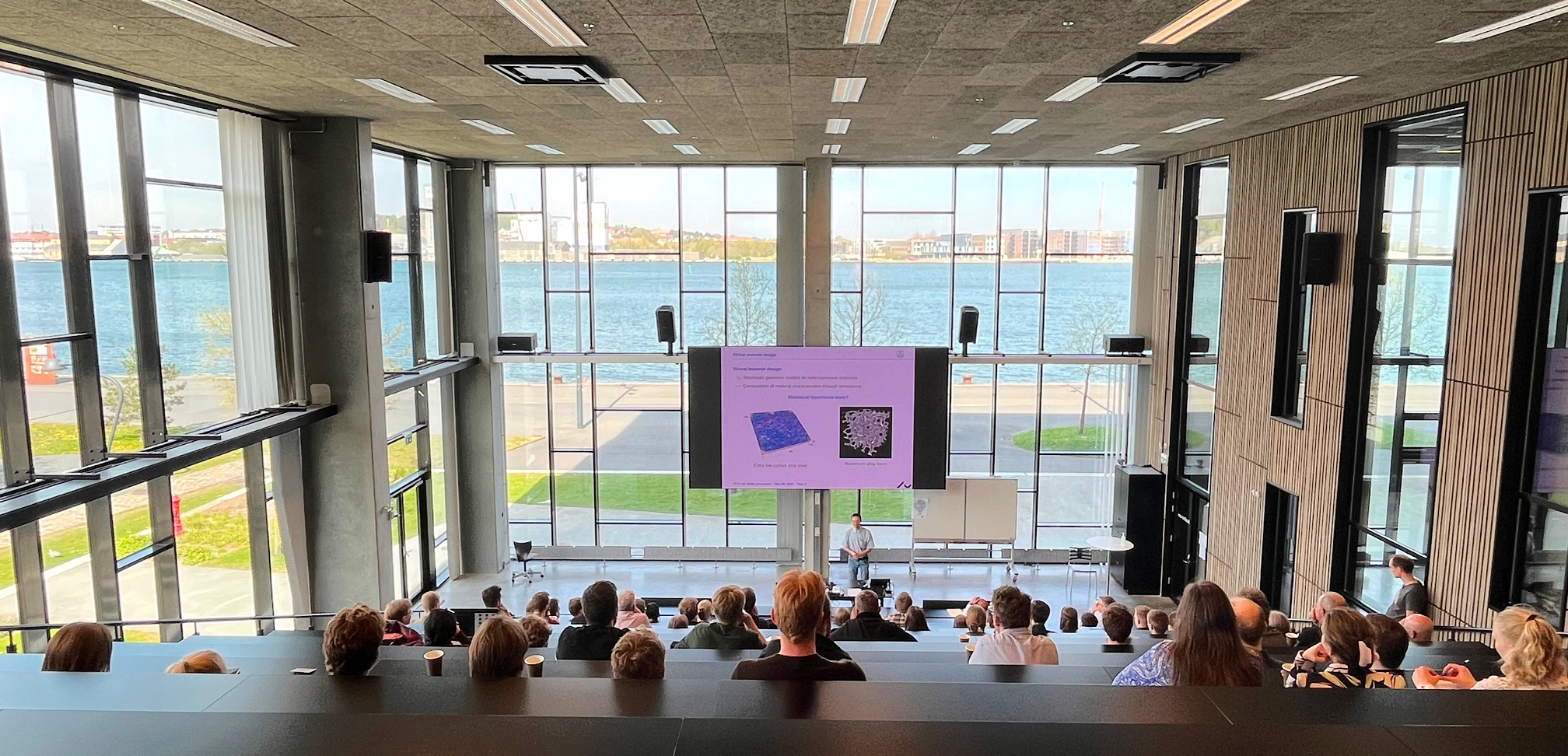Todagesmøde forår 2023
Spectacular sunshine welcomes 87 participants to DSTS’s 2023 two-day meeting in Aalborg
Held at the breathtaking Aalborg University building by the harbor, this exceptional venue offered an ideal backdrop for delving into cutting-edge statistical research and applications. Amidst the exchange of ideas, attendees had the chance to reunite with old friends and forge new connections. Of the 87 participants, 38 were students.
The conference was a great success, with many informative and engaging talks delivered by experts in the field of statistics as well as an enriching social programme (including a dinner at Det Glade Vanvid and a visit to the famous Jomfru Ane Gade). The conference featured a diverse range of topics, ranging from probability theory and data science to the roles of a statistician in the pharmaceutical industry.
The presentations were of high quality, and the discussions that followed were engaging and thought-provoking. The conference also provided ample networking opportunities, allowing attendees to connect with colleagues and establish new collaborations.
Christian Hirsch and Moritz Otto kicked off the meeting with a talk on “Central limit theorems for point processes with focus on Gibbsian functionals”. Christian introduced statistical inference for spatial point processes and explained why it is of interest and what tools are needed for working with this type of data. Moritz continued with the theoretical foundations in terms of a central limit theorem for certain point processes, including characteristics (like stabilization).
Niklas Pfister and Anton Rask Lundborg continued with their talk “Inferring Causality in Microbial Communities: Goals and Challenges”. Niklas and Anton introduced compositional data where the data has constraints (e.g. sums to one), and how this type of data naturally arises for microbial communities. They proceeded to give examples of what statistical problems will appear in this setting and how to deal with (some of) them.
Emiko Dupont presented work on spatial confounding with a talk entitled “Spatial confounding and spatial+ for non-linear covariate effects”. Confounding might arise if both covariates (like social-economic status) and outcome (like disease risk) have a spatial component. Emiko explained how such problems were traditionally addressed and presented a method to avoid some problems with other methods.
Christophe Biscio and Anne Marie Svane presented work on topological data analysis with their talks “Introduction to Topological Data Analysis for beginners” and “Asymptotic Results for Topological Data Analysis on Point Processes”. Christophe motivated the research and explained about invariant quantities for shapes, topological features and persistent homology. Anne Marie introduced how to apply topological data analysis in the realm of point processes and continued with asymptotic results for the approach.
Sneha Das presented work on speech and audio with the talk “Low-resource Data Modelling for Speech and Audio - Perspectives from Statistics and Machine Learning”. This work included speech representation, generation, processing, emotions and recognition. There was also a detailed discussion on how to do such processing in a low-ressource setting and how to transfer learning from one environment to another (e.g. between languages).
Søren Byg Vilsen gave a presentation entitled “On the use of machine learning in battery health monitoring”. The idea was to model the health state of a battery in a realistic setting, and not in an ideal laboratory setting. One difference between the two is e.g. whether a battery gets fully discharged and charged in a continuous fashion during every cycle, which happens in the lab, but does not happen in a real-life setting. Hence, this talk was also focused on transferring learning from one environment to another.
Anders Gorst-Rasmussen finished the meeting by discussing the health technology assessment function in a pharmaceutical company. Most people know of the clinical trials function in pharmaceutical companies, but once a drug has been approved, the company is also interested in getting approval from the health technology assessment bodies by doing health economy modeling. There is also a great need for transfer learning in the sense that studies may have found the effect of drug A vs B, others of drug A vs C, but none of drug B vs C, and such indirect comparisons are often requested by authorities. To make these comparisons, one typically needs to combine different data sources (e.g. data at an individual level with data at an aggregate level) which limits the modeling options.
In summary, the scientific conference on statistics held in Aalborg was a great success, providing a valuable platform for researchers and professionals to exchange ideas and discuss the latest developments in the field.
Looking forward to seeing new and familiar faces for the next two-day meeting!
This blogpost was written by Christoffer Sejling, Claus Ekstrøm, and Mikkel Meyer Andersen, all members of DSTS UFP (Udvalg for Formidling og Presse / Committee for Dissemination and Press).
